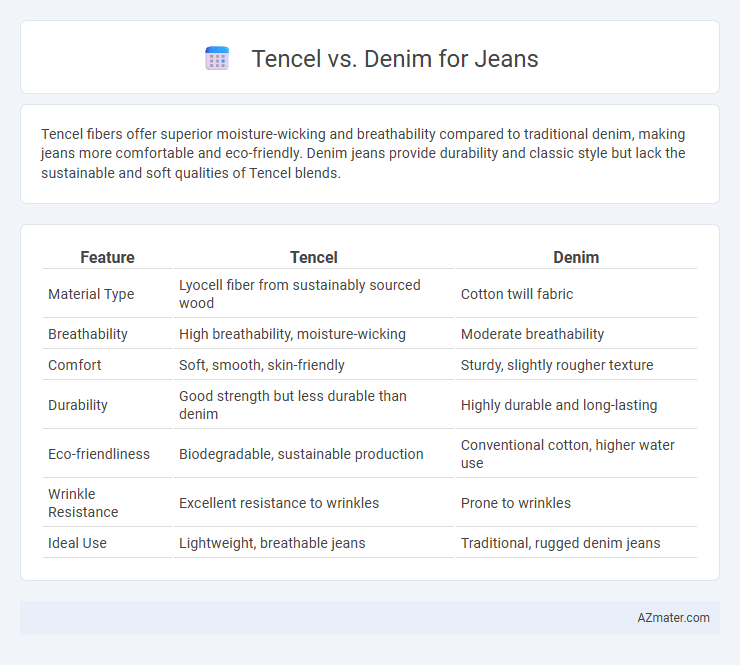Tencel fibers offer superior moisture-wicking and breathability compared to traditional denim, making jeans more comfortable and eco-friendly. Denim jeans provide durability and classic style but lack the sustainable and soft qualities of Tencel blends.
Table of Comparison
| Feature | Tencel | Denim |
|---|---|---|
| Material Type | Lyocell fiber from sustainably sourced wood | Cotton twill fabric |
| Breathability | High breathability, moisture-wicking | Moderate breathability |
| Comfort | Soft, smooth, skin-friendly | Sturdy, slightly rougher texture |
| Durability | Good strength but less durable than denim | Highly durable and long-lasting |
| Eco-friendliness | Biodegradable, sustainable production | Conventional cotton, higher water use |
| Wrinkle Resistance | Excellent resistance to wrinkles | Prone to wrinkles |
| Ideal Use | Lightweight, breathable jeans | Traditional, rugged denim jeans |
Introduction to Tencel and Denim
Tencel, a sustainable fabric derived from wood pulp, offers exceptional breathability and softness, making it an innovative alternative to traditional denim. Denim, a sturdy cotton twill textile, is renowned for its durability and classic aesthetic, dominating the jean market for decades. Comparing Tencel and denim highlights a shift toward eco-friendly materials without sacrificing style or comfort in jeans.
What is Tencel?
Tencel is a sustainable fabric made from eucalyptus wood pulp through environmentally friendly processes, prized for its softness, breathability, and moisture-wicking properties. Unlike traditional denim, which is typically cotton-based and heavier, Tencel offers a lightweight, smooth texture ideal for comfortable, eco-conscious jeans. Its natural fibers also promote durability and reduced environmental impact, making Tencel jeans a preferred choice for sustainable fashion.
What is Traditional Denim?
Traditional denim is a sturdy cotton twill fabric characterized by its distinctive diagonal ribbing and indigo-dyed warp threads, commonly used in classic jeans. It offers durability and a rigid structure that softens and fades uniquely with wear over time. The fabric's weight and weave provide robust performance, making it a preferred choice for long-lasting, casual wear garments.
Tencel vs Denim: Fabric Composition
Tencel fabric, derived from sustainably sourced eucalyptus wood pulp, consists primarily of lyocell fibers known for their softness and moisture-wicking properties, while denim is traditionally made from 100% cotton fibers that provide durability and a rugged texture. Tencel's eco-friendly production process uses a closed-loop system minimizing water and chemical usage, contrasting with conventional denim's heavier water and pesticide footprint during cotton farming. The blend of Tencel with cotton in denim jeans enhances breathability and flexibility, offering a more comfortable alternative to pure cotton denim without compromising strength.
Comfort and Breathability Comparison
Tencel jeans offer superior comfort and breathability compared to traditional denim due to their natural cellulose fibers, which enhance moisture-wicking and softness. Denim, often made from cotton with a tighter weave, tends to provide less airflow, leading to a heavier, less breathable feel. Tencel's eco-friendly production process also ensures a lightweight and smooth texture, making it an ideal choice for breathable, comfortable jeans.
Durability and Longevity
Tencel jeans offer superior moisture-wicking properties and softness but typically have less durability compared to traditional denim, which is made from cotton twill known for its rugged strength and long-lasting wear. Denim's dense weave and reinforced stitching contribute to its resistance against wear and tear, making it a preferred choice for longevity in jeans. While Tencel blends enhance comfort and sustainability, pure denim remains the benchmark for durable, long-lasting jeans.
Sustainability and Environmental Impact
Tencel jeans utilize fibers derived from sustainably managed eucalyptus forests, requiring significantly less water and energy compared to conventional denim production. Denim manufacturing involves considerable water consumption, chemical dyes, and pesticide use for cotton cultivation, contributing to environmental pollution and resource depletion. Tencel's biodegradability and lower carbon footprint make it a more eco-friendly alternative for sustainable jeans.
Style and Aesthetic Differences
Tencel jeans offer a smooth, silky texture with a natural sheen, creating a sleek and modern aesthetic, while denim typically provides a rugged, textured appearance associated with classic and casual styles. The drape of Tencel fabric allows for a more fluid, tailored fit that enhances sophistication, contrasting with denim's stiffer structure that emphasizes durability and a vintage appeal. Color vibrancy in Tencel is often richer due to its fiber properties, whereas denim colors may fade over time, contributing to its distinctive worn-in look.
Care and Maintenance Requirements
Tencel jeans require gentle washing in cold water and air drying to maintain fabric softness and prevent shrinkage, while denim typically demands less delicate care but benefits from cold washes to preserve color and fabric integrity. Tencel fibers are more prone to damage from harsh detergents and high heat, necessitating the use of mild detergents and avoidance of tumble drying. Denim is more durable in frequent washes but may fade faster if washed improperly or too often.
Which is Best for Jeans: Tencel or Denim?
Tencel offers superior breathability and softness, making it ideal for comfortable, lightweight jeans suitable for warm weather, while denim provides greater durability and classic ruggedness favored for long-lasting everyday wear. Jeans made from Tencel blend often include cotton or elastane to enhance flexibility and reduce environmental impact with its sustainable fiber source. Choosing between Tencel and denim depends on priorities such as softness and eco-friendliness versus toughness and traditional style.

Infographic: Tencel vs Denim for Jeans
 azmater.com
azmater.com